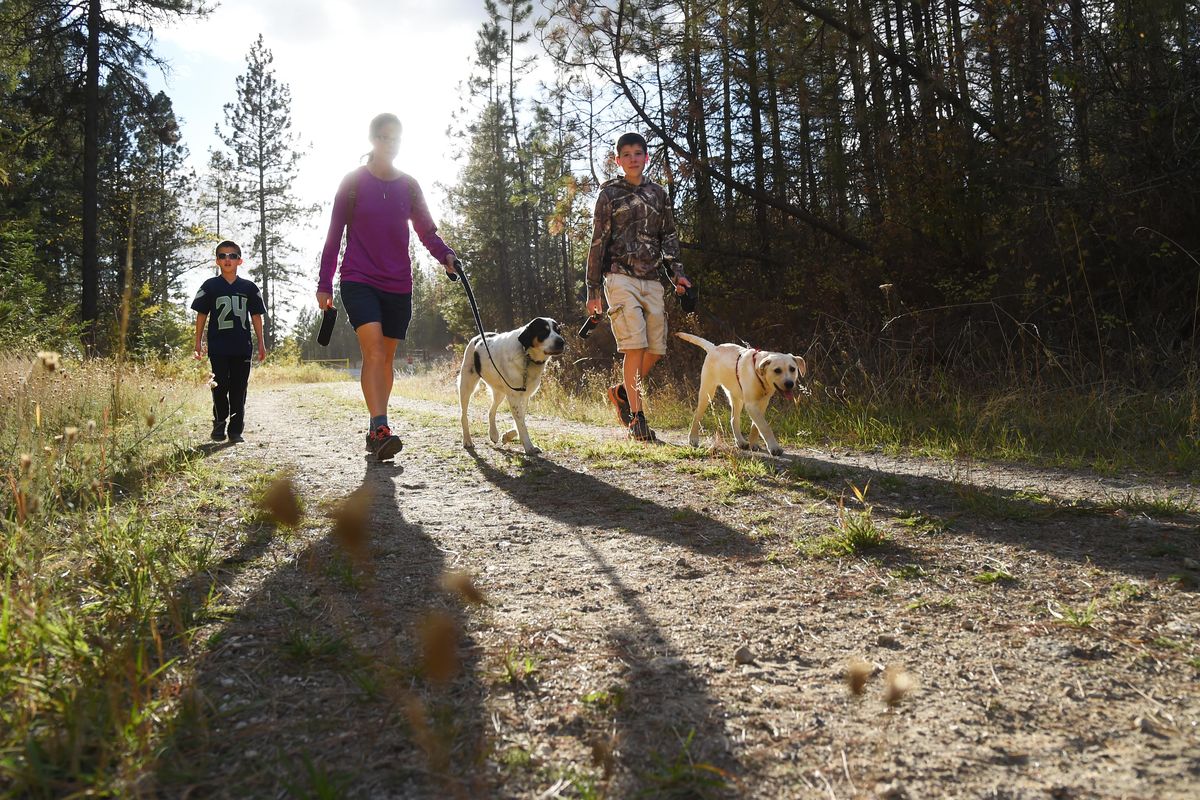Mica Peak trail system in the works for land acquired through conservation program

“We just walked up and said, ‘Oh my gosh,’ ” said Lori Clark, surrounded by her sons McCade, Sean and Brendan, and the family’s two dogs, Cassie and Gunner.
The parking lot is the first step Spokane County park planners took to revitalize more than 900 acres of former logging land southwest of Liberty Lake. Earlier this month, the county accepted $48,000 in state grant money to develop a trail system that could accommodate hikers, horseback riders and mountain bikers.
The Mica Peak area is one of more than 30 properties the county has acquired since 1994 as part of a property tax-supported program to preserve natural areas for wildlife and recreation. The Conservation Futures program levies a 4.67-cent tax on every $1,000 of a property’s assessed value.
The county bought the Mica Peak property in 2013 for $1.6 million. Paul Knowles, who oversees the county’s Conservation Futures program, said the area was highly sought after for its variety of plant and animal life, as well as its location near the 3,600-acre Liberty Lake Regional Park.
“There’s a lot of vertical elevation on the property,” Knowles said. “It’s appealing for hikers, and mountain bikers, and horseback riders. You really get that workout climbing to the top.”
The property also has drawn the interest of the Spokane Audubon Society and other wildlife conservation groups. Moose, deer, elk, cougars, bats and hummingbirds all have been reported in the area.
Knowles and Doug Chase, the county’s park director, toured the land last week and got an up-close look at some of the wildlife.
“There are a lot of moose up here, a lot of deer,” Knowles said, when fluttering wings from nearby brush turned both his and Chase’s head.
“And grouse,” Knowles acknowledged.
Hunting is not allowed on Spokane County conservation lands.
The grant money the county accepted will be spent developing a trails plan that satisfies all the needs of various outdoors groups. Chase and Knowles said they’re reaching out to groups such as the Evergreen East Mountain Biking Alliance and Washington Trails Association the Backcountry Horsemen and others right now so they’re involved in the process from the beginning.
Volunteers will donate hours toward the project by hiking and riding the trails, then telling park staff what they’d like to see in the system, Knowles said.
“It’s really kind of user-based from the get-go,” he said.
The property is nestled between land owned by the Washington Department of Natural Resources and Inland Empire Paper Co., and existing logging roads serve as the current trail system.
Inland Empire Paper is a subsidiary of Cowles Co., which publishes The Spokesman-Review.
Knowles said ideally the county could acquire some property owned by Inland Empire to the east of the current conservation area, allowing a connection between Mica Peak and the Liberty Lake park.
Jeff Lambert, executive director of the Dishman Hills Conservancy and a former adviser to county parks, said there’s a “terrific opportunity” to link up recreation and conservation land in the area, including the Saltese Uplands Conservation Area.
“It won’t be easy, but if the connection is made, the benefit to the community will be an extremely large area for recreation and interconnected wildlife habitat,” Lambert said.
County Commissioner Shelly O’Quinn, whose district includes Mica Peak and the other nearby recreation areas, said she’s excited by the new property. But to continue caring for acquired lands, counties should be allowed to spend a greater amount from their Conservation Futures fund on maintenance, she said.
State law requires that 15 percent of the fund be used for maintenance, and 85 percent be used to acquire new property.
“Fifteen percent doesn’t go very far,” O’Quinn said. “It’s too restrictive.”
Spokane County has backed efforts in the Washington Legislature to increase the fund amount that can be spent on maintenance, but so far those efforts have been unsuccessful. O’Quinn said commissioners will continue to make that argument.
“We’re going to get to a point where we can’t acquire any more land,” she said.
In the past several contracts the county has signed with private property owners to obtain conservation land, a provision has been included that portions of the sale be put into a trust to pay for future upkeep.
Chase said the community has become more aware of the Conservation Futures program over its 21 years of existence in the county. More visitors are taking advantage of the properties, many of which are within the Spokane city limits.
“I think the website, having trail maps available, and working closely with these different organizations, they do a fantastic job getting the word out to their members and their friends,” Chase said.
The Clarks, after a trip to the nearby portable toilet and leashing their dogs, set out on the trail as the sun began to dip in the sky. Lori Clark said each hike was an adventure.
“It’s a lot of fun,” she said. “There’s something new every time.”
McCade Clark, who’s ridden the trails on a 26-speed mountain bike, had a specific request for the county.
“They’re nice,” he said of the old logging roads that crisscross the property. “They should put in some jumps, though.”
Editor’s note: A previous version of this story incorrectly stated the rate at which property is taxed to fund the Conservation Futures program. The story has been updated to correct that error.